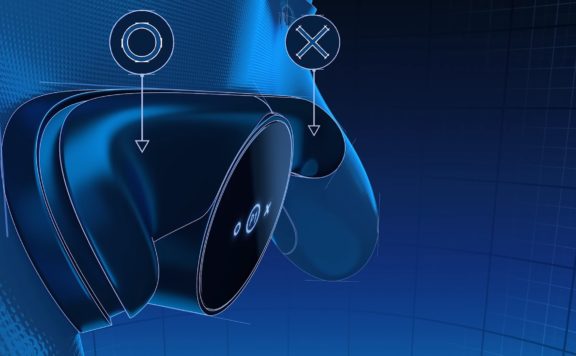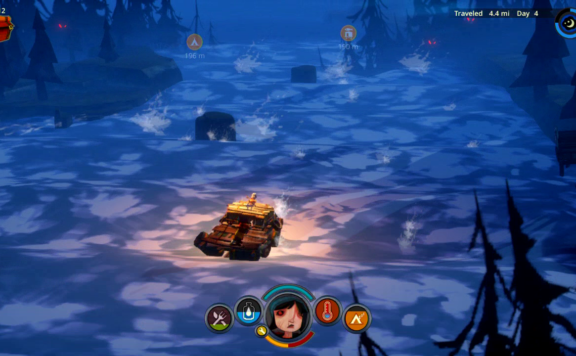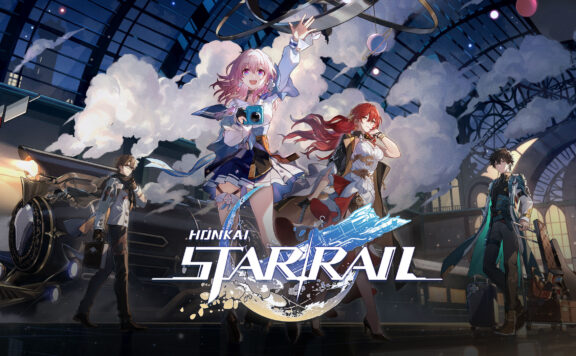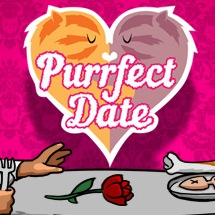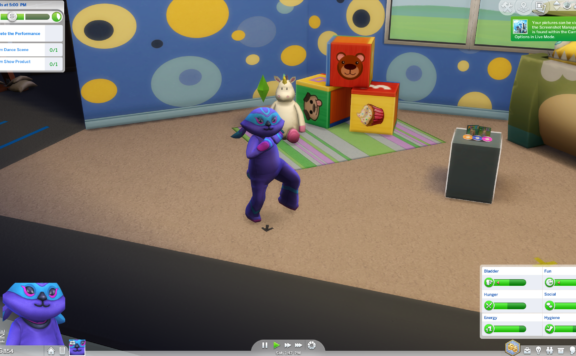This week, Dreadnought left dry dock and warped onto Playstation 4. This is where GameSpace.com‘s co-op aficionados Matt and Dame took it out for a spin. These two have been gaming together for more than fifteen years over, spanning multiple genres of games. It was only a matter of time before they got to space combat! Welcome to our Dreadnought review for the PS4.
Before we dive into the conversation, what is Dreadnought?
Dreadnought is a team based, tactical warfare game putting you at the helm of a capital ship as part of a five-man team. In these matches, it is your role to outlast your opponents. As you destroy enemy ships, your team gains points at a rate of four per ship destroyed. After reaching a goal off 100 points, your team is victorious.
Q: Out of the gate, what was your first impression of Dreadnought?
Dame: For me, I had to rearrange my thinking on what type of ship-based combat we were dealing with here. My most recent foray into this arena has been the Starfighter Assault mode of Star Wars Battlefront II, but the scale is much, much different. These aren’t the high-mobility crafts, but slower, requiring more deliberate positioning and situational awareness.
I’m not going to lie, initially, I found it awkward – me, more so than the game. However, the more that we played and the more I got used to how my ship handled and the role I was filling, the more enjoyable it was! This is definitely a game that I would love to get a full party of friends together with to try out.

Matt:I’ve spent a lot of time playing Star Trek Online over the years and initially I was expecting a similar ship combat experience. In many ways Dreadnought really feels and plays like STO with its grand ship battles with position and resource management playing an integral part of the experience.
The biggest difference (and biggest strength) is that Dreadnought uses a twitch targeting system instead of traditional tab targeting system. This offered some great creativity and strategic thinking in regards to combat. I loved how the game felt and played during combat sessions.
Q: Dreadnought brags about having a fleet of over fifty ships spread across five different classes (heavy, assault, sniper, support, and scout). Which class did you gravitate toward and why?
Matt: Board and sword has been my go to in any game with classes for several years now. I wish I could say that I experimented with trying new classes but I’m a pretty straightforward guy. So when it came time to pick classes in Dreadnought I when for the biggest, toughest ship I could find. I’ve spent most of my play time running the Heavy ships leaning in on hitpoints, shielding, and straight firepower to overcome my lack of mobility and, shall we say, finesse during combat.
Dame: I am a support guy, through and through – not just in gaming. I love enhancing what other people are already doing. In team-based games like this, they really bring that part of my personality out in me a little bit more. Keep in mind, when I say support, I don’t just mean healing. Like running hybrid builds that allow me to heal, but also to pull out those quick takedowns along the way.
Q: If you couldn’t play as that ship class, which would you choose?
Matt: My fallback when tanking isn’t an option is to take up an assault roll offering as much firepower to the situation as I possibly can. I take the motto “the best defence is a strong offense” quite literally opting for straight firepower to kill all of the things as quickly as possible. If I can’t tank defensively than I’m going to tank offensively throwing down as much pew pew as I can while still being able to hold my own.
Dame: If I couldn’t run support, I would probably choose a scout-class ship. The whole gun-boat thing doesn’t do it fo me. I need speed and maneuverability even if it means I’m a little more squishy. Is that the right term? Can ships be squishy?
Q.: With the mixture of ships and play styles, Dreadnought is obviously meant to be played as a team. What stood out to you about group dynamics?
Matt: I think what made the group play so great for me was the required teamwork for success. Dreadnought does a great job at providing a need for each class in combat and thus, as a tank, I really relied on on you to keep me alive when I would jump into battle taking on way more than I could handle, which is typically how it works out when we group up!
Dame: Going back that idea of having a support vessel, I was blown away at just how big of a game-changer that having one at your side could be! We had a few games where, Matt, you were running a heavy ship and you just unloaded on a cruiser only to discover they had a support ship just out of sight keeping it repaired. Now, this made for a great pick up kill for me, but added a layer of strategy to the game!

Q: Let’s talk progression and currencies. Most games have some form of progression system and currencies that allow you to purchase equipment and upgrades. How did you find the progression system within Dreadnought and what about the different currencies?
Dame: Okay, so this one if a little bit of a doozy for me. I like progression and I like about two-thirds of this system. I really don’t like that other third, but I am conflicted by it. Let me explain: Dreadnought is a free-to-play game that has currency packs which can be purchased is real-world money. You can use this in the in-game store for cosmetic items and to unlock hero ships. You can also use it to purchase a subscription to the game.
Now, Dreadnought also gives your a currency to research technology for specific ships, a currency to buy the technology, and one that can be used between ships as well. The place where I struggle with this is when the game tells you, “Hey, you COULD be making THIS much of the other currencies IF you’d just pay a subscription fee. I understand that this is how they make money off of the product that they produced – and I want them to! It’s gorgeous and a lot of fun. It just feels a little weird being told “Well, kid, you could be making this much, but you’re not in the cool kids club!” I guess I’m not sure that letting people know that you’re throttling their progression is the right motivator for people to spend money. Maybe I’m wrong.
Full disclosure: we were provided with a currency pack to test out Dreadnaught, but outside of subbing, I didn’t see much to spend it on.
Aside from that, I love the unique nature of the different ships you can unlock and the different equipment load outs available to them.
Matt: As you have already explained the progression system, I want to simply add that aside from the above mentioned I really enjoyed that each match seemed to offer a good amount of experience needed to progress. The ships are broken down by tiers with a full tier tree in place that essentially maps out the progress of your character. I never really felt like I was grinding currency any any point as each battle felt both satisfying to play and the rewards gained felt balanced.
The system is a bit of a head scratch to understand initially but after about a half our I seemed to understand how and where to put my points to progress down the Dreadnought class tree. Overall I am quite happy with how progression is handled.
Q.: Last question here: outside of the team battles, there is a Havoc mode which pits you against wave after wave of AI controlled ships. Thoughts?
Dame: Three words: Mistakes were made. We went into this mode without really paying attention to what it was and, oh man, were we not prepared for that! It was wave after wave of pretty powerful enemies with different handicaps and bonuses per round. They also gave us different ships to use than the ones we had been playing with, so that felt a little weird.
Here is what I loved about Havoc mode was this: it changed the pace of the game. I felt like this mode has an even higher risk-to-reward ratio as you only get one ship to use. Once your team is dead, you’re toast… and not even the good kind!
Matt: Havoc was a representation of what I love best about group experiences. It was clutch. We were out of our element, out of our regular routine of play and forced to think fast and really know how the other person works to make it out alive. I personally love being thrown into something new and having to figure it out on the fly. Havoc was a great change up from our typical group dynamics.
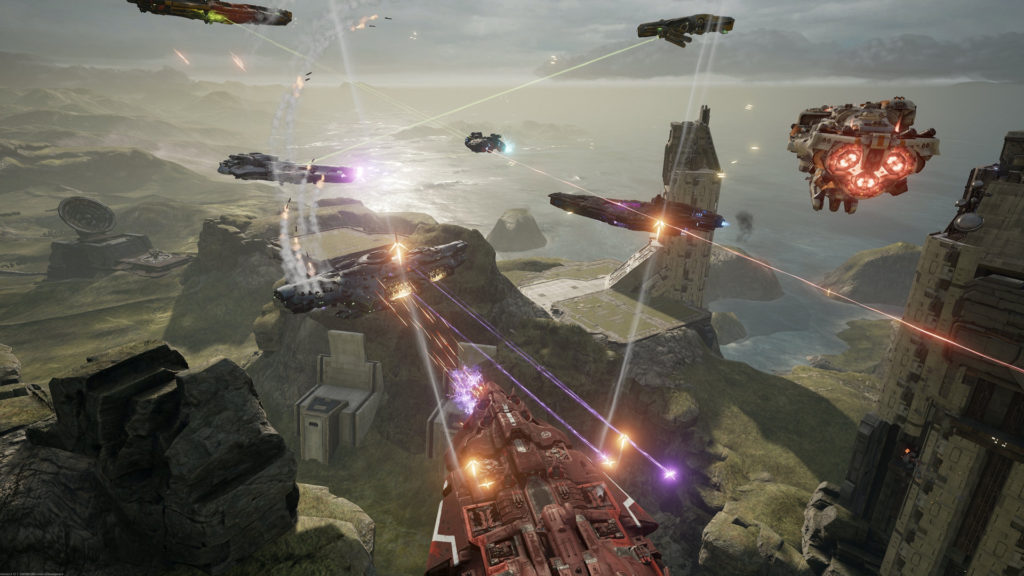
Final Thoughts:
I found Dreadnought to be surprisingly enjoyable as a cooperative experience. There was something very satisfying about calling out ship locations to Matt and taking down the enemy together. If you have a group for friends that you game with, there is nothing better than finding cooperative experiences to bring you together and Dreadnought provides that. The great news is that it has a very low risk entry point… it will only cost you a little bit of hard drive space.
So, call the hail the fleet, fire up your thrusters, and watch your aft, because with a good group flying together in Dreadnought, the cavalry has arrived!
Note: Our copies were reviewed on Playstation 4 with codes provided by PR.
COMPARE TO: Fractured Space, Star Wars Battlefront II (Starfighter Assault)
OVERALL SCORE: 7/10
PROS:
- It is a gorgeous looking game
- Ship classes makes sense and plays well together
- Havoc mode changes up the gameplay with a high-stakes, high-reward experience
CONS:
- Constant reminders of throttled progression for non-subscribers
- Slower paced combat


